英语电影赏析ppt
合集下载
经典英文电影赏析ppt课件
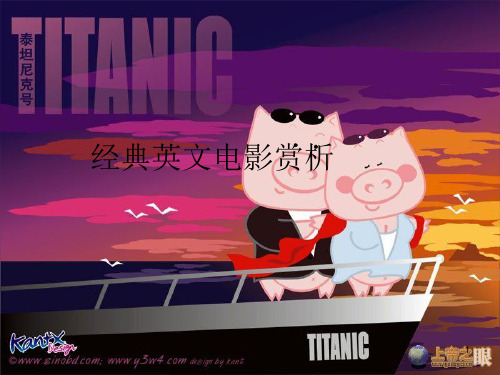
Mexico""hugging each other""after tens of years suffering• 我非常喜欢这部影片,因为它始终在提醒着我要珍惜
in the prison" I think it is so wonderful that it can't be
生活中的美好,要努力为自己赢得尊严。当然,最重
在度过了数十年痛苦的监狱生活之后两个老友在美丽自由的墨西哥海滩上拥抱彼此这样的美好画面和它所包含的情感是难以用语言表达我非常喜欢这部影片因为它始终在提醒着我要珍惜生活中的美好要努力为自己赢得尊严
经典英文电影赏析
1
2
《肖申克的救赎》简介
The film I would like to introduce to you is known to a l•ot 译文:
13
• I figure life is a gift and I don’t intend on wasting it. You never know what hand you’re going to get dealt next. You learn to take life as it comes at you.
• 3.Miracles happen every day. • 奇迹每天都在发生。
9
• . Death is just a part of life, something we're all destined to do.
• 死亡是生命的一部分,是我们注定要做的一件事。 • . I don't know if we each have a destiny, or if
英语电影赏析ppt
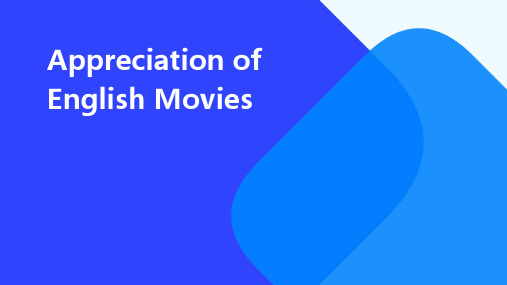
01
Fundamentals of Film
The origin of movies can be traced back to the late 19th century, when the Lumi è re brothers invented the Cinematography and screened the first short films Since then, movies have developed quickly and become one of the most popular art fo Narrative Techniques and Techniques of Movies
02
Overview of English Movies
The History and Cultural Background of English Movies
The birth of English movies: The development of English movies can be traced back to the late 19th century, when the first motion pictures were created English filmmakers quickly realized the potential of this new media and started to produce movies that reflect the culture and society of the country
Appreciation of English Movies
CATALOGUE
目录
Fundamentals of Film Overview of English Movies The Language Characteristics of English Movies The Cultural Annotation of English Movies Recommendation Methods for English Movies Film reviews and recommendations for English movies
英语电影赏析ppt课件
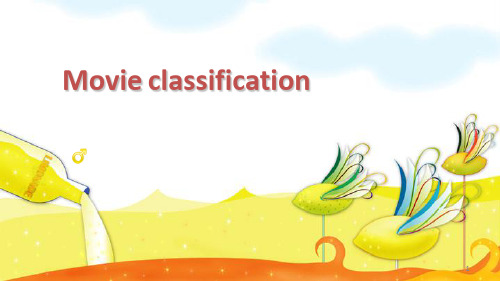
片
9
• Kitchen Sink Film(Social Realist Film) 现实片
• Melodrama 情节片、家庭情节剧 • Morality Play 道德剧、伦理片 • Musical Film 歌舞片、音乐剧 • Opera Film (Film Opera) 歌剧片 • Preteen Film 儿童片 • Propaganda Film 宣传(煽动)片 • Realist Film现实片、现实主义电影 • Revisionist Film 修正主义电影 • Revolutionary Film (激进)革命电影 • Situation Comedy 情景喜剧 • Soap Opera肥皂剧、连续剧 • Surrealist Film超现实主义电影 • 3-D Film 三维(立体)电影 • Whodunit推理片,神秘惊悚片
4
Romance/ Romantic Film(浪漫片)
It is a sub-type of dramatic film which dwells on the elements of romantic love.
5
Thriller Film( 惊悚片、悬疑片)
•A kind of movie which is intended to provoke excitement and/or nervous tension into audience.
6
Slapstick (Classical Comedy) 丑角喜剧、经典喜剧
•It is a type of comedy involving exaggerated physical violence or activities which exceed the boundaries of common sense,
9
• Kitchen Sink Film(Social Realist Film) 现实片
• Melodrama 情节片、家庭情节剧 • Morality Play 道德剧、伦理片 • Musical Film 歌舞片、音乐剧 • Opera Film (Film Opera) 歌剧片 • Preteen Film 儿童片 • Propaganda Film 宣传(煽动)片 • Realist Film现实片、现实主义电影 • Revisionist Film 修正主义电影 • Revolutionary Film (激进)革命电影 • Situation Comedy 情景喜剧 • Soap Opera肥皂剧、连续剧 • Surrealist Film超现实主义电影 • 3-D Film 三维(立体)电影 • Whodunit推理片,神秘惊悚片
4
Romance/ Romantic Film(浪漫片)
It is a sub-type of dramatic film which dwells on the elements of romantic love.
5
Thriller Film( 惊悚片、悬疑片)
•A kind of movie which is intended to provoke excitement and/or nervous tension into audience.
6
Slapstick (Classical Comedy) 丑角喜剧、经典喜剧
•It is a type of comedy involving exaggerated physical violence or activities which exceed the boundaries of common sense,
外国电影鉴赏 英文PPT课件
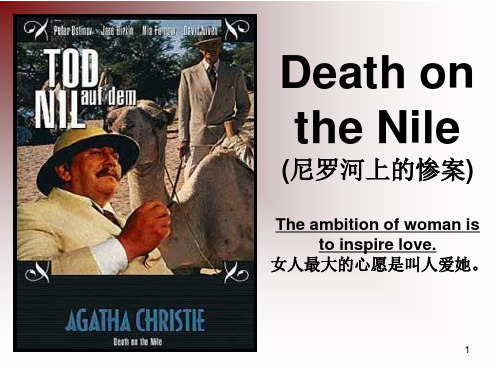
6
Linnet was shoted and dead at a peaceful night. • Poirot, as a clever detective,decided to discovery the real facts and find out the murderer. Jackie ,Linnet’s servant, The writer, Linnet’s secretary……Almost every have the evidence to prove them to be innocent.
husband’s girlfriend
西蒙Simon, Linnet’s husband
林内特Linnet,a fascinating and
wealthy girl
奥特伯恩太太 Otterbourne,a romance-novel
writer
4
About the breathtaking plot Linnet is a young and beautiful woman,who
8
• Mrs.Otterbourne was shot by a gun when she talked with Poirot and wanted to tell him about some clues about Linnet’s death.
• Famous detective Poirot feel puzzled about this case. But ,the more complicated the situation, the closer to the real facts and Poirot solved these problems quickly. In my opinion, The murderer and the way Linnet was killed is unbelievable.
Linnet was shoted and dead at a peaceful night. • Poirot, as a clever detective,decided to discovery the real facts and find out the murderer. Jackie ,Linnet’s servant, The writer, Linnet’s secretary……Almost every have the evidence to prove them to be innocent.
husband’s girlfriend
西蒙Simon, Linnet’s husband
林内特Linnet,a fascinating and
wealthy girl
奥特伯恩太太 Otterbourne,a romance-novel
writer
4
About the breathtaking plot Linnet is a young and beautiful woman,who
8
• Mrs.Otterbourne was shot by a gun when she talked with Poirot and wanted to tell him about some clues about Linnet’s death.
• Famous detective Poirot feel puzzled about this case. But ,the more complicated the situation, the closer to the real facts and Poirot solved these problems quickly. In my opinion, The murderer and the way Linnet was killed is unbelievable.
英语电影赏析选修PPT课件
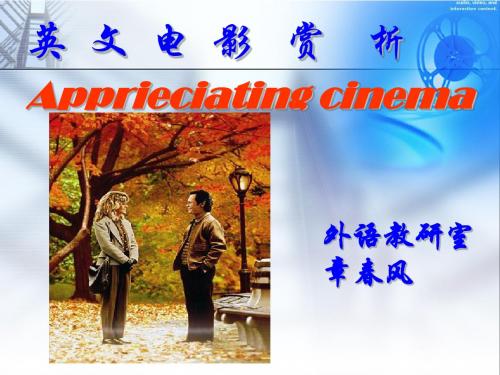
1. 1826
The technological groundwork for motion
pictures was laid by the invention
o2f. p1h8o8t9ographyThe key breakthrough came with the
introduction by
3. 1890s Thomas KEoddiaskonofancdelLluumlioeirde. brothers in
Culture refers to the entire way of life of a society.
All of these only could be found in movies.
英文电影
赏 析 3. Different culture with different valu Culture refers to state of intellectual development of a society and the customs, arts, social institutions, etc. of a particular group or people.
1. Introduction
English Movies ------- English Motion Pictures
In order to make us familiar to British and American intonation and pronunciation, to understand the inter-culture between China and Western countries, to understand the background and culture in the movies, to get sensibility of native speaking to know the way of main media impact on modern social life, to be ware of the schools of literature and its effect to the motion picture industry, there are enough reasons to see English language movies.
《电影欣赏英文》课件

Movie Appreciation English PPT courseware
目录
Fundamentals of FilmFilm Language and ExpressionRecommendation of Classic English MoviesCross cultural elements in moviesAesthetics and Reflection on Movies
Social terms
03
Movies can also reflect different social terms, such as etiquette, behavior, and clothing, which can lead to cultural differences and misunderstandings
Camera movements
Pan: Move the camera from side to side
Tilt: Move the camera up and down
Dolly
Move the camera forward or back
Track
Move the camera left or right on a track
Match cut: Connection between two shots that create a visual rhythm or parallelism
03
Special effects: Physical illusions or stunts, e.g., stunt driving, explorations
Social justice
Movies often explore social justice issues such as power, discrimination, and justice
英语电影赏析ppt
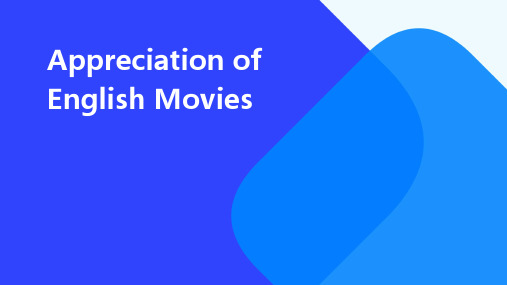
English movies also explore various moral values, such as good and evil, right and wrong, loyalty, etc. For example, Saving Private Ryan emphasizes loyalty and a spirit of sacrifice.
Features
English movies have a variety of styles, including realistic simplicity and naturalness, romantic aestheticism, and avant-garde innovation in modernism. At the same time, English movies are also good at absorbing elements from other cultures, forming diverse style characteristics.
Genres
English films have developed into various genres, such as realism, romanticism, naturalism, etc., which have had a profound impact on later film production.
Classification
English movies can be classified based on various criteria such as theme, style, and production region, such as drama films, comedy films, action films, horror films, etc.
Features
English movies have a variety of styles, including realistic simplicity and naturalness, romantic aestheticism, and avant-garde innovation in modernism. At the same time, English movies are also good at absorbing elements from other cultures, forming diverse style characteristics.
Genres
English films have developed into various genres, such as realism, romanticism, naturalism, etc., which have had a profound impact on later film production.
Classification
English movies can be classified based on various criteria such as theme, style, and production region, such as drama films, comedy films, action films, horror films, etc.
英语电影赏析ppt

Chapter 5 Critical Perspectives
The Definition of Theme Typical Thematic Concerns
Auteur Theory Structuralism Feminism and Gender Studies
.
1
Introduction
2. Life Philosophies
3. Religious and Ethical Concerns
4. Historical Issues
5. Nations and National Characteristics
6. Social/Cultural/Technological Changes
1. Broad Human Concerns 2. Life Philosophies 3. Religious and Ethical Concerns
.
6
Typical Thematic Concerns
Here is an overview of some of the forms in which theme is expressed in Hollywood (and other Englishlanguage) films:
2. Life Philosophies
3. Religious and Ethical Concerns
4. Historical Issues
5. Nations and National Characteristics
6. Social/Cultural/Technological Changes
1. Broad Human Concerns 2. Life Philosophies 3. Religious and Ethical Concerns 4. Historical Issues
The Definition of Theme Typical Thematic Concerns
Auteur Theory Structuralism Feminism and Gender Studies
.
1
Introduction
2. Life Philosophies
3. Religious and Ethical Concerns
4. Historical Issues
5. Nations and National Characteristics
6. Social/Cultural/Technological Changes
1. Broad Human Concerns 2. Life Philosophies 3. Religious and Ethical Concerns
.
6
Typical Thematic Concerns
Here is an overview of some of the forms in which theme is expressed in Hollywood (and other Englishlanguage) films:
2. Life Philosophies
3. Religious and Ethical Concerns
4. Historical Issues
5. Nations and National Characteristics
6. Social/Cultural/Technological Changes
1. Broad Human Concerns 2. Life Philosophies 3. Religious and Ethical Concerns 4. Historical Issues
英语电影影评ppt-PPT精品文档

An unexpected powerful forces of evil a deadly threat to the Earth, consisting of six superheroes - "Iron Man", "Thor", "Captain America", "Hulk", "Black Widow" and "Eagle Eye“ The Avenger Union "came into being to fight for peace.
The reason they're brought together in "The Avengers" is that the Earth is under threat by the smirking Loki (Tom Hiddleston), Thor's adopted brother, who controls the Tesseract, a pulsing cube of energy that opens a gateway to the universe; through it, he plans to attack Earth with his fleet of reptile-looking monster-machines. It goes completely unexplained where Loki now resides, how these dragonmachines are manufactured, and so on. Both Loki and Thor are obscurely related to the gods of Norse mythology, as we know from last year's "Thor," but let's not drift into theology.
The reason they're brought together in "The Avengers" is that the Earth is under threat by the smirking Loki (Tom Hiddleston), Thor's adopted brother, who controls the Tesseract, a pulsing cube of energy that opens a gateway to the universe; through it, he plans to attack Earth with his fleet of reptile-looking monster-machines. It goes completely unexplained where Loki now resides, how these dragonmachines are manufactured, and so on. Both Loki and Thor are obscurely related to the gods of Norse mythology, as we know from last year's "Thor," but let's not drift into theology.
- 1、下载文档前请自行甄别文档内容的完整性,平台不提供额外的编辑、内容补充、找答案等附加服务。
- 2、"仅部分预览"的文档,不可在线预览部分如存在完整性等问题,可反馈申请退款(可完整预览的文档不适用该条件!)。
- 3、如文档侵犯您的权益,请联系客服反馈,我们会尽快为您处理(人工客服工作时间:9:00-18:30)。
(Example: Tristan & Isolde 《王者之心》)
The Wandering Jew
流浪的犹太人
The
“Wandering Jew” is the story of the persecuted or alienated traveler who will never return home.
The English Patient《英国
(Examc Stories
Achilles (阿喀琉斯), Candide (憨第德), Cinderella (灰姑娘), Circe (喀尔刻), Faust (浮士德), Orpheus (俄尔普斯), Romeo and Juliet (罗密欧与朱丽叶), Tristan (特里斯坦), the Wandering Jew (流浪的犹太人).
The Classic Three-Act Linear Structure
The majority of Hollywood films employ the classic three-act linear structure (or a variation of it). The structure was firstly codified(整理) by Syd Field, but has since been elaborated and reinterpreted by a number of scriptwriters and theorists. By no means all films will adhere to this structure,and those that do will do so flexibly. Nevertheless, most Hollywood scriptwriters(编剧) are familiar with the structure and acknowledge its importance.
Narrative
Narrative A chain of events in cause-effect relationships(因果 关系) occurring in time and space. Story All the events that we see and hear, plus all those that we infer or assume to have occurred, arranged in their presumed causal relations, chronological order, duration, frequency, and spatial locations. Plot All the events that are directly presented to us, including their causal relations, chronological order, duration, frequency, and spatial locations. The key distinction is that between story and plot: Story is the viewer’s imaginary construction of all the events in the narratives---whether presented to us or not---while plot is the film’s actual presentation of certain events in the narrative.
Describe the commonly used the Classic Three-Act Linear Structure (经典三幕式直线结构). Describe the varieties of subplot.
Narrative
Narrative
refers to the way that a story is
Faust 浮士德
The story of an individual who sells his soul to the devil, enjoys a brief period of power and prosperity, but eventually is called upon to repay the debt. The Faust story can also take the form of the dark secret that can never be completely suppressed, or the personal history that cannot be evaded. (Example: Wall Street《华尔街》)
Orpheus 俄尔普斯
The story of the gift that is taken away. The gift could be something personal, a loved one, an ability of some kind, everything valuable in life, or even life itself. The story can focus on the tragedy of the loss itself or the search that follows the loss. (Example: Born on the Fourth of July 《出生于七月四日》)
Candide 憨第德/天真汉
The
story of the innocent abroad, the naively optimistic hero who triumphs contrary to all expectations. Forrest Gump《阿甘正传》, Mr. Bean《憨豆先生》)
Romeo and Juliet
The
classic “star-crossed lovers (命运 不佳的情侣 )” story in which a major obstacles stands in the way of true love. (Examples: Ghost 《人鬼情未了》)
The Basic Stories
Writers have argued that there are a limited number of stories that form the basis for ALL fictional narratives. These stories have been named Achilles (阿喀琉斯), Candide (憨第德), Cinderella (灰姑娘), Circe (喀尔刻), Faust (浮士德), Orpheus (俄尔普 斯), Romeo and Juliet (罗密欧与朱丽叶), Tristan (特里斯坦), and the Wandering Jew (流浪的犹太 人). They can occur alone or in combination.
Tristan 特里斯坦
The love triangle: A man loves a woman, but one of them is already involved with someone (or something else). The “third party” in the relationship is usually a person, but it may be something more abstract (e.g. a cause, a mission, a destiny).
(Examples:
Cinderella 灰姑娘
The story of the “dream comes true”: Goodness and virtue are despised at the beginning but recognized at last. The protagonist of the Cinderella story usually begins in a lowly position but, through his good nature, convinces all doubters (怀疑者) and is rewarded. (Example: Pretty woman《漂亮女人》)
Circe 喀尔刻
The “Chase” story in which an innocent victim is pursed by the villain, until the villain is defeated by the potential victim. Often this story takes the form of the temptress (诱惑男人的女性) ensnaring (诱捕) the love-stuck ( 被爱情冲昏了头的 ) male; it has often been vividly described as “the spider and the fly”. It is the basis of horror films, thrillers, and film noir. (Examples: the Alien films《异形》系列)
told. It is principally concerned with the way that events are organized in time and space — the way in which the scriptwriter and director take the raw elements of a story and arrange them in the most attractive and interesting way.
